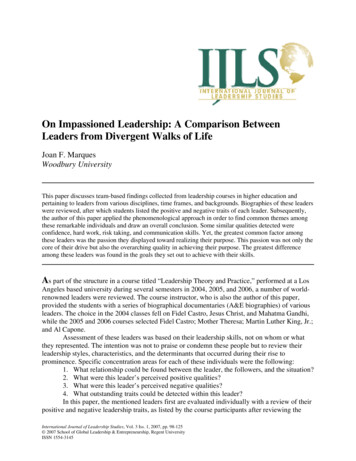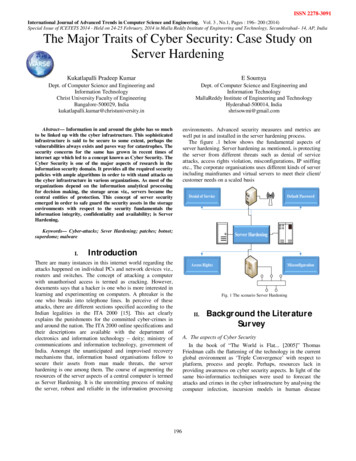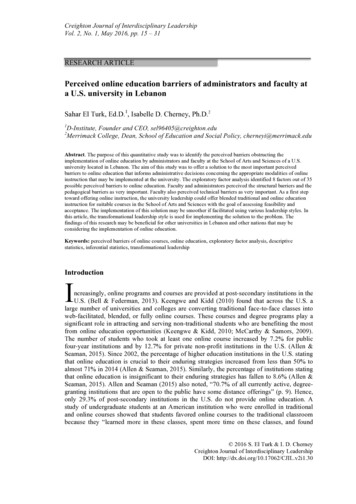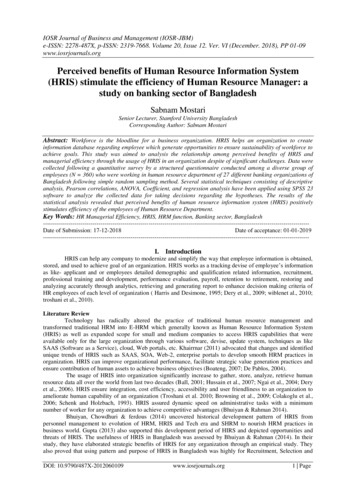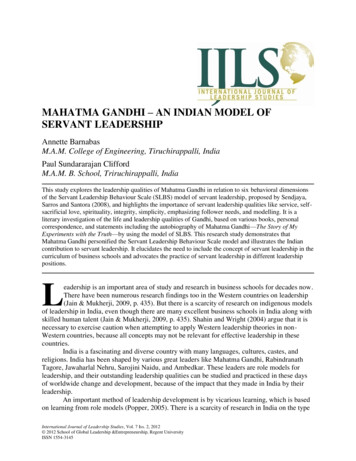
Transcription
Creighton Journal of Interdisciplinary LeadershipVol. 1, No. 1, May 2015, pp. 24 – 50RESEARCH ARTICLESelf-perceived traits of servant leadership in AmeriCorpsVolunteers: A mixed method concurrent explanatory studyKaren F. Cook, Ed.D.Creighton University, Graduate School, Instructor, karencook@creighton.eduAbstract. Although the tenets of modern servant leadership originated by Greenleaf (1970) have long beenapplied to service enterprise, no known research has applied the principles to the self-perception of AmeriCorpsvolunteers who commit to one year of service. The purpose of this mixed-method study was to determine whethervolunteers who commit to one year of national service identify with characteristics and behaviors of modernservant leadership in order to operationalize the volunteer leadership experience for both the volunteer and thesponsoring agency, and to provide volunteers with personal awareness of their experiences. The quantitativeportion of the study employed the results of 51 self/leader reports of Barbuto and Wheeler’s (2006) ServantLeadership Questionnaire (SLQ) to discover that some significance existed between their original study and thisstudy. The qualitative portion involved gathering information from 10 semi-structured, individual interviews.Analysis revealed two major themes: personal awareness responses and direct action responses. These themessupported favorable responses to the research questions. Empirical and narrative responses allow directors andleaders of AmeriCorps and long-term service programs to consider alternatives by which to discern incomingapplications, reinforce candidate self-awareness, and provide a foundation for future research.Keywords: AmeriCorps, servant leadership, intentional community, mixed-methodIntroductionAmeriCorps, founded in 1993 as a result of President Clinton’s National andCommunity Service Trust Act (National and Community Service Trust Act, Pub. L.No. 103-82), is the network of national service programs designed to involve Americancitizens in rigorous service and help meet the country’s needs, including volunteer support ineducation, health, and public safety (AmeriCorps, 2014). Furthermore, AmeriCorps is “anetwork of local, state, and national service programs that connects more than 75,000Americans each year in intensive service to meet our country’s critical needs” (Corporationfor National and Community Service, 2014). Included in highly variable aspects ofAmeriCorps programs are individual and team-based services, training and memberdevelopment, contact with service beneficiaries, multiple project choices, diversity amongprogram participants, and leadership opportunities (Epstein, 2009). “Ethic of Service” appearsin AmeriCorps literature to describe civic engagement and readiness to serve others.AmeriCorps’ pledge (2014) expresses the essence of service and willingness of members toplace the well-being of others before their own (Bruell, 1997). The Georgia Commission forService and Leadership (, 2011) noted that AmeriCorps program directors merge multipledoctrines of servant leadership into their orientation and training of AmeriCorps members.The model of modern servant leadership was presented in 1970 by AT&T executiveRobert K. Greenleaf (1970) in the publication of his short book, The Servant as Leader. Apopular essayist and manager, Greenleaf consulted with businesses and educationalinstitutions on how to transform ineffective leadership models into prototypes whose 2015 K. F. CookCreighton Journal of Interdisciplinary LeadershipDOI: http://dx.doi.org/10.17062/CJIL.v1i1.21
Self-Perceived Traits of Servant Leadership in AmeriCorps Volunteers 25programs foster a desire to serve first. The primary and foundational characteristic of servantleadership originated with the idea that one has:a natural feeling that one wants to serve, to serve first. Then, a conscious choice bringsone to aspire to lead. That person is sharply different from one who is leader first, perhapsbecause of the need to assuage an unusual power drive or to acquire material possessions.The leader-first and the servant-first are two extreme types. Between them there areshadings and blends that are part of the infinite variety of human nature. (Greenleaf,1970, p. 7)A commitment to serving the needs of others and the surrounding community is the heartof servant leadership. Rather than a leadership model focused simply on the needs of leaders,this service-first ethic became the focus of leadership scholars in AmeriCorps. Despite apresumably natural fit between servant leadership and AmeriCorps, no known researchdelved into identifying traits of servant leaders as depicted in Greenleaf’s original model inapplication to AmeriCorps volunteers. Servant leadership is not a topic researched broadly(Parris & Peachey, 2012), and much of the literature articulates user-specific, qualitative, anddecidedly circumstantial research (Barbuto & Wheeler, 2006; Beck, 2009; Russell & Stone,2002). Greenleaf’s vision—that service be a core value of the philosophy (Keith, 2008)—directed organizations and institutions to execute the servant leadership model, yet literaturethat combines AmeriCorps and servant leadership is scarce.The pinnacle of an organization’s success depends on two variables: people and theorganization itself. Pairing the two is an area of inquiry organizational behavioristscontinually question (Avolio, Walumbwa, & Weber, 2009; Irving & Longbotham, 2009).Service and education sectors can no longer afford to mismatch leadership assets withorganizational cultures and expectations. Light (2008) forecasted increased need for civicleadership in both public and non-profit sectors due to an influx of expected retirements ingovernment. An additional concern for role fulfillment is an expected increase in AmeriCorpsvolunteers to 250,000 by 2020 (AmeriCorps, 2014). With intensified need for civic leadershipservice, how will AmeriCorps define transformative governance? Before creating guidelinesto fill projected needs, gathering information regarding present strengths of AmeriCorpsleaders through the servant leadership model is essential.The purpose of this study was to determine whether year-of-service volunteers identifiedwith traits of Greenleaf’s model of servant leadership (Greenleaf, 1970). The intent of thismixed methods concurrent explanatory study (Creswell & Plano, 2006) was to attainquantitative results with a web-based survey while interviewing a sample of the sameparticipants using semi-structured interviews. Although several organizations under theAmeriCorps umbrella incorporate the servant leadership paradigm, efforts are sporadic andwell intentioned, but not uniform. By identifying servant leadership traits in national year-ofservice volunteers, empirical and narrative data can generate organizational change andefficacy, and determine work site assignation of future volunteers. Provided to participants,this same data offers information and insights to support participant understanding ofbehavioral leadership.A recent, systematic literature review of servant leadership theory in organizationalcontexts (Parris & Peachey, 2012) identified servant leadership as sustainable inorganizations, leading to investigation across multiple contexts. Researchers espouse thatservant leadership remains understudied yet is still practiced conspicuously in meeting roomsand as a business paradigm (Parris & Peachey, 2012; Spears, 2010). Criteria for inclusion inthe literature review included only publications from peer-reviewed journals, “servant leader”as a search term, and collection of quantitative or qualitative data. Thirty-nine studies met thecriteria. Parris and Peachey’s (2012) sample incorporated 11 qualitative studies, 27quantitative studies, and one mixed-method study. Of the 39, none linked servant leadershipto AmeriCorps, intentional communities, year-of-service, or service year. 2015 K. P. CookCreighton Journal of Interdisciplinary LeadershipDOI: http://dx.doi.org/10.17062/CJIL.v1i1.21
26K. F. CookGreenleaf’s highlight was a lifestyle choice rather than management design (Greenleaf,1977). This study employed volunteers who obliged themselves to both a year of intentionalliving (endeavoring toward a common vision) (Intentional Communities, 2013) and one yearof service. Determining the current state of servant leadership research, Parris and Peachey(2012) surmised that investigation was needed to determine personal characteristics andleader qualities. Accordingly, Beck (2009) researched antecedents of servant leadership andcalled for further research, noting the sample lacked cultural and geographical multiplicity.This study responded to Beck’s call by recruiting volunteers who resided in several states andwho were of varying ethnicities. This study represents the first mixed-method study thatcombined Greenleaf’s model of servant leadership lifestyle and self-perceived leadershiptraits in AmeriCorps national year-of-service volunteers. Assumptions included thatAmeriCorps volunteers held experience in leadership roles, and thus identified with tenets ofservant leadership. Second, AmeriCorps volunteers identified with the description andexplanation of Greenleaf’s model of a servant leader. The research sought to answer thefollowing:1. Do long-term and AmeriCorps volunteers self-identify with traits of servantleadership?2. What information regarding self-perceived leadership traits in year-of-servicevolunteers emerge from semi-structured interviews?3. Were the traits of servant leadership modeled for the volunteers prior to committing toresiding in an intentional (i.e., based on mutual principles) community?Delimitations of this study included current male and female AmeriCorps year-of-servicevolunteers who resided in the United States. These volunteers lived within intentionalcommunities, and each held a minimum of a bachelor’s degree. Each committed to 1,700hours of service and participated in the study between weeks 46 and 50 of the 50-weekobligation. Each participant was between the ages of 23 and 61 and all were Americancitizens who had prior volunteer experience.MethodsThe research design, approved by the Institutional Review Board at Creighton University,Omaha, Nebraska (IRB# 13-16791), was a mixed- method concurrent explanatory design(Creswell & Plano, 2006). The purpose was to determine whether self-perceived traits ofservant leadership were present in AmeriCorps volunteers to operationalize the servantleadership model.Two primary considerations emerged in the study: verifying servant leadership traits andunderstanding assigned meaning from their experiences. The first consideration was to obtainempirical data in a quantitative survey to verify servant leadership traits, using Barbuto andWheelers’ (2006) Servant Leadership Questionnaire (SLQ), Self (or Leader) only. The SLQwas appropriate as it focuses on individual leaders, in comparison to those focusing on otherdesign variables, such as moral and ethical servant leadership frameworks (Patterson, 2003),organizational servant leadership frameworks (Laub, 1999), servant leadership and changemanagement frameworks (Kool & Dierondonck, 2012), and follower impressions of a leaderframework (Dennis & Bocarnea, 2005). The SLQ asks participants to rank their thoughts andbehaviors surrounding servant leadership using a 5-point Likert scale, identifying the degreeto which the characteristics most accurately describe them. To answer research questionnumber one, the self-identity of AmeriCorps volunteers as servant leaders, analyzed data setswere compared to Barbuto and Wheeler’s (2006) original analysis. In both studies, leadersused Likert scale response choices 0 Not at all, 1 Rarely, 2 Sometimes, 3 Fairly Often,4 Frequently, if not always, and significance of 0.05 (p 0.05). When developing the leaderversion of the SLQ, Barbuto and Wheeler’s subjects were members of a professionalorganization attending a statewide convention. These leaders were elected to their positions,
Self-Perceived Traits of Servant Leadership in AmeriCorps Volunteers 27and all were permanent residents in the Midwestern United States. All held at least abachelor’s degree; the average age was 51 years, 65% were women and 35% were men(Barbuto & Wheeler, 2006).According to Barbuto and Wheeler (2006), the SLQ sampled in 2002 measured 11 tenetsof servant leadership described by Greenleaf (1970) and identified by Spears (2010): calling,listening, empathy, healing, awareness, persuasion, conceptualization, foresight, stewardship,growth, and community building (Barbuto & Wheeler, 2002). A factor analysis reduced thedata to five independent subscales that were subsequently used to test reliability andconvergent, divergent, and predictive validity. These five servant leadership factors “appearto be conceptually and empirically distinct” (Barbuto & Wheeler, 2006, p. 318): altruisticcalling, emotional healing, organizational stewardship, persuasive mapping, and wisdom.Altruistic Calling is a firmly held desire to make a positive difference in the life of someone(Barbuto & Wheeler, 2006). The desire is coupled with a generosity of spirit often associatedwith philanthropy. Leaders scoring highly in the domain of altruistic calling naturally put theneeds of others before their own. Emotional healing depicts a leader’s commitment and desireto foster spiritual recovery from hardship or trauma. Leaders who employ emotional healingare highly empathic and skilled in active listening, adding to their proficiency in healing.These leaders create environments that are safe to voice personal and professional issues.Organizational stewardship is highlighted by the degree and depth to which leaders arrangefor the stakeholders of an organization to make a positive contribution to the communitythrough development and outreach. A group’s mission, ethics, vision, and values aretransparent and res
Wheelers’ (2006) Servant Leadership Questionnaire (SLQ), Self (or Leader) only. The SLQ was appropriate as it focuses on individual leaders, in comparison to those focusing on other design variables, such as moral and ethical servant leadership frameworks (Patterson, 2003), organizational servant leadership frameworks (Laub, 1999), servant leadership and change management frameworks (Kool .


